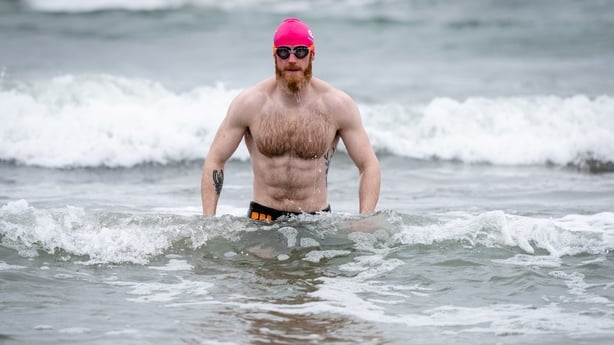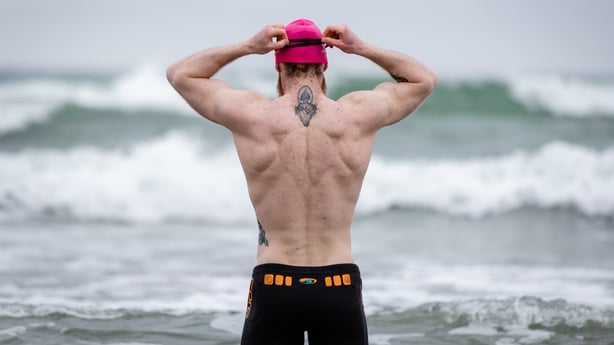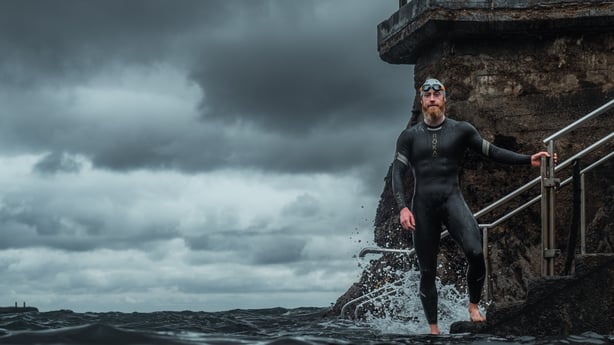We present an extract from Unsinkable, the new book from by Alan Corcoran.
Weeks after a joy-filled footballing trip around France, joined by family and friends, Alan Corcoran learned his dad, Milo, had stage four cancer. Just days later, Milo died. Grief-stricken, twenty-five-year-old Alan decided to raise money for charity by attempting a 500-kilometre length-of-Ireland sea swim (fifteen times the distance of the English Channel) from the Giant's Causeway on the north coast to County Waterford on the south coast.Corcoran takes to the pool and prepares in solitude. Eight months later, he dives into the coldest deep end to begin his open-water swimming adventure. Will he sink or swim?
Nobody had swum the length of Ireland from the north or south coast to the opposing shore. I could make the story more epic with just a bit of extra effort.
Around the corner from Ireland's northeast tip is the Giant’s Causeway, a UNESCO World Heritage Site. An ancient Irish warrior giant, Fionn mac Cumhaill, forged the outcrop of 40,000 hexagonal basalt columns to help him walk across the Irish Sea and battle the Scottish giant, Benandonner. I’m not sure about you, but jumping into the deep from giant 60-million-year-old volcanic pillars sounds damn more exciting than waddling in from Ballycastle Beach.
Around the corner from the southeast tip of the country is my hometown of Waterford. Since I’d already decided on the length of Ireland, what was another little bit between friends?
I wish I could say there were more considerations in the equation and that I had researched hazards before extending the route, but I hadn’t. I always wanted to see the Giant’s Causeway, and swimming home felt right.
We need your consent to load this Vimeo contentWe use Vimeo to manage extra content that can set cookies on your device and collect data about your activity. Please review their details and accept them to load the content.Manage Preferences
Watch a preview of Alan Corcoran's documentary Unsinkable, coming to RTÉ
Though the waypoints were around the corner on a map, the ill-considered decision had its pitfalls. It added a thirty-kilometre section of the north coast, the most hazardous area of the route. I’d just learned about the orcas lurking in the waters. It also had the coldest and deepest waters, fastest tides, overfalls, eddies, and whirlpools! The additional south coast section from Carnsore Point to my home passed through 'The Cemetery of a Thousand Ships’ and added roughly one hundred kilometres of swimming to the task. The things we do for love.
The National Trust opened its doors early for us before the crowds of tourists arrived. Mam, Ev, and I followed our tour guide through the visitor centre and out the back of the modern structure submerged in the protected landscape like a villain’s lair. There was a wall of green dotted with rock and gorse bushes to our right, the paved descending path straight ahead, and the never-ending Atlantic Ocean below to our left, lapping against the magical shore.

what was another little bit between friends?' (Pic: David Murphy)
The giant’s black steps loomed four storeys over me at the base of the towering basalt cliffs. I got into my tried-and-tested wetsuit that ranged in thickness from 1.5–4.5 millimetres – thicker around the core for warmth and thinner around the joints for ease of movement. I also donned my ten-millimetre-thick neoprene hood and five-millimetre-thick neoprene gloves and socks.
I wish Dad could see this. I’d meant to visit the legendary natural wonder with Dad when we’d recced the around-Ireland run route over a long-weekend drive, but we’d run out of time and had to keep moving. It was an experience we never got to share.
I looked up to greet the crew. I didn't know whether to laugh or cry.
I hugged Mam and Ev and climbed to the top of the hardened magma steps to get a photograph with the Waterford flag raised overhead. To reach this point, I had endured early mornings of crying in grief en route to the pool in sub-zero temperatures, thousands of lengths, pain, exploding lungs, freeze-thaw, vanishing boats, and grey hairs. It was a victory for me to reach the start line. I did it. I can do this.
The orange RIB motored into sight and bobbed 400 metres offshore.
‘Looks like they’re floating,’ I said. ‘That’s promising.’
‘Best of luck, Al. Some achievement already, in all fairness. Mind yourself, okay,’ Ev said.
‘Please be careful, please, Al,’ Mam said.
I slipped on my small green fins, clipped my tow float around my waist, and dived with a splash. I waved goodbye to my family alone on the rocks and turned to swim towards Tim and Paul.
Oh, Christ! I was out of breath. What’s going on? Maybe you’re going too fast with the adrenaline. Slow it down, nice and flowy, relax, calm yourself.

I'd put in months of consistent training, swimming for hours at a time. I’d splurged on all the right gear and had had no severe reactions to the cold during the recent open-water test swims. When I reached the support boat, I felt like I’d finished a race and was more than a bit concerned.
The wild coast of Northern Ireland wasn’t the London Docklands in the blistering southeast of England, nor was it shallow water above the underfloor-heated, sandy, south-coast beaches of Ireland. One hundred metres of icy blackness flowed beneath me. The sea temperature hovered around 8°C (46°F), about half the temperature of the open training waters and just three degrees shy of meeting the International Ice Swimming Association’s regulation ‘ice swim’ temperature. The cold shock chopped me down with the crash of falling timber, humbling me back to the dirt from which I thought I’d risen.
I looked to land, the sea splashing my bearded chin. Removing my head from the sea provided relief and a moment to catch my breath. The giant’s rocks looked like organ pipes chiselled by a master sculptor. From the sea, it was a modest mound at the feet of the sheer lush cliffs. I was half a kilometre from the rugged Area of Outstanding Natural Beauty and felt awed by nature’s allure and power.

(Pic: Niall Meehan)
I looked up to greet the crew. I didn’t know whether to laugh or cry. Paul, a six-foot-seven, twenty-stone bearded mountain of a man, was sitting in the back of the oddly balanced boat, scooping water from around his feet with a sliced plastic milk carton and plopping it back into the sea.
‘How’re you feeling? Alright?’ he said.
‘Probably better than yee, by the looks of things,’ I said, deflecting attention from my panic and hoping they didn’t notice my shortness of breath. I didn’t need them worrying about me from the word go: He’s gasping at the start; has he done any training whatsoever? ‘How’re things looking up there? Much water on board?’
‘Leave us to worry about that,’ Tim said. They looked concerned, but I wasn’t sure if it was because of the state of me or their slowly sinking ship. ‘It’s alright when we’re moving. The second we sit for a minute, water’s creeping in, but we can manage it.’

Unsinkable by Alan Corcoran is out now - find out more here - the documentary of the same name, tracing Alan Corcoran's amazine voyage, receives its Irish TV premiere on Sunday, September 3rd on RTÉ One and will be available to watch on RTÉ Player.

